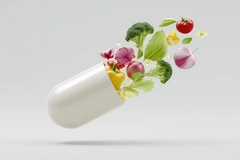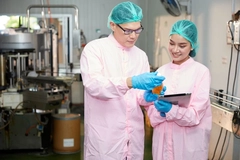Titanium dioxide deemed “not safe” in EFSA verdict
07 May 2021 --- The European Food Safety Authority (EFSA) no longer considers titanium dioxide (TiO2) to be a safe food additive. Also known as E171, TiO2 is commonly used as a color in the nutrition industry, including as an opacifier in capsules. This safety assessment update follows a request by the European Commission in March 2020.
“Taking into account all available scientific studies and data, the panel concluded that titanium dioxide can no longer be considered safe as a food additive,” says Maged Younes, chair of EFSA’s expert panel on Food Additives and Flavourings (FAF).
A critical element in reaching this conclusion is that EFSA could not exclude genotoxicity concerns after consumption of titanium dioxide particles. After oral ingestion, the absorption of titanium dioxide particles is low. However, they can accumulate in the body, Younes states.
Accelerating interest?
“The use of TiO2 has been under discussion for a long time, and extends into many industries, since TiO2 has many applications both in and beyond food,” Stéphane Vouche, Lonza’s marketing manager, tells NutritionInsight.
In light of this conclusion, he anticipates that the interest the company is already seeing in TiO2-free alternatives will accelerate.
EFSA’s conclusion that a concern for genotoxicity of TiO2 particles cannot be ruled out means that an Acceptable Daily Intake (ADI) cannot be established for E171.
Genotoxicity is related to the ability of a chemical substance to damage DNA, the genetic material of cells. As genotoxicity may lead to carcinogenic effects, it is essential to assess the potential genotoxic effect of a substance to conclude its safety.
At most, E171 contains 50 percent of particles in the nano range to which consumers may be exposed.  EFSA’s scientific advice will be used by risk managers to inform any decisions they take on possible regulatory actions.
EFSA’s scientific advice will be used by risk managers to inform any decisions they take on possible regulatory actions.
What happens now?
Currently, TiO2 is authorized as a food additive in the EU according to Annex II of Regulation (EC) No 1333/2008.
EFSA’s conclusion will not immediately ban E171. Any legislative or regulatory decisions on the authorizations of food additives are the responsibility of the risk managers, such as the European Commission and member states.
They will now use EFSA’s scientific advice to inform any decisions they take on possible regulatory actions.
Notably, France has already banned food products containing TiO2, with this implementation coming into force at the start of 2020.
The hunt for alternatives
In the food supplement space, TiO2 is mostly used for its ingredient-masking capabilities, explains Vouche.
As the white pigment has come under increasing scrutiny in recent years, industry has been looking for alternatives.
In February, Colorcon expanded its Nutrafinish Film Coatings portfolio to include “Label Friendly” and “TiO2-Free” coatings for the nutritional and dietary supplements market.
“Elimination of TiO2 in film coatings for nutritional and dietary supplements provides manufacturers with an alternative coating finish that satisfies aesthetic appeal while addressing current market concerns,” a Colorcon spokesperson tells NutritionInsight.
“As dietary supplements are often dark or mottled in appearance, which makes total coverage challenging, there was a need to continue to improve opacity while limiting the amount of coating needed,” they continue.
Meanwhile, Lonza’s Vcaps Plus White Opal capsules were released in 2019 and use calcium carbonate to avoid TiO2.
“The industry has been heavily decreasing its reliance on TiO2 for food supplement applications in the EU over the last couple of years,” observes Vouche.
However, Innova Market Insights reports that global supplement launches with TiO2 continue to rise, with a CAGR of 5 percent from 2016 to 2020. West Europe is the leading region and has seen a CAGR of 7 percent. In contrast, North America – which currently has the second most launches – is seeing a drop of -12 percent (CAGR, 2016 to 2020).
Within the supplement category, TiO2 is found most commonly in vitamins and minerals, followed by botanical and herbal offerings.
According to EFSA, other food uses for TiO2 include fine bakery wares, soups, broths, sauces, salads and savory-based sandwich spreads.
Processed nuts are also a main food category for adults and the elderly that may harbor TiO2. [800x800].jpg) As a food color, TiO2 is used to increase visual appeal or give color to products that would otherwise be colorless.
As a food color, TiO2 is used to increase visual appeal or give color to products that would otherwise be colorless.
A long history
EFSA’s assessment followed a rigorous methodology and took into consideration many thousands of studies that have become available since EFSA’s previous assessment in 2016, including new scientific evidence and data on nanoparticles.
E171’s safety was initially re-evaluated by the EFSA ANS Panel in 2016 in the frame of Regulation (EU) No 257/2010, as part of the re-evaluation program for food additives authorized in the EU before January 20, 2009.
In its 2016 opinion, the ANS Panel recommended new studies be carried out to fill the gaps on possible effects on the reproductive system, which could enable them to set an ADI.
Uncertainty around the characterization of the material used as a food additive was also highlighted, in particular with respect to particle size and particle size distribution of titanium dioxide used as E171.
In 2019, EFSA then responded to a review from the French Agency for Food, Environment and Occupational Health Safety (ANSES). EFSA said that the ANSES opinion reiterated the uncertainties and data gaps previously identified by EFSA and did not present findings that invalidated the Authority’s previous conclusions on the safety of titanium dioxide.
In the same year, the Netherlands Food and Consumer Product Safety Authority (NVWA) also delivered an opinion on possible health effects of TiO2, which highlighted the importance of examining immunotoxicological effects in addition to potential reprotoxicological effects.
By Katherine Durrell












